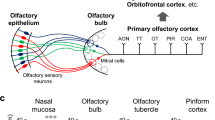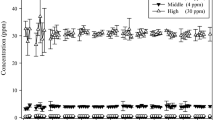Abstract
The monohalomethanes (methyl iodide, methyl bromide and methyl chloride) are widely used industrial methylating agents with pronounced acute and chronic toxicity in both experimental animals and man. Recently inhalation exposure of rats to methyl bromide has been shown to result in severe olfactory toxicity. This study examined the effects on the rat nasal cavity of inhalation of methyl iodide (100 ppm for 0.5–6 h), and demonstrated that methyl iodide is a more potent olfactory toxin than methyl bromide. Within the nasal cavity the olfactory epithelium was the principle target tissue, and it was only at high doses (600 ppm.h) that limited damage to transitional epithelium occurred. The squamous and respiratory epithelia were consistently unaffected. Within olfactory epithelium the sustentacular cells were the primary cellular target and damage to sensory cells appeared to be a secondary event. Methyl iodide induced olfactory damage was reversible, and 2 weeks after exposure almost complete repair had taken place.
Similar content being viewed by others
References
Banger KK, Lock EA, Reed CJ (1993) The characterization of glutathione S-transferases from rat olfactory epithelium. Biochem J 290: 199–204
Banger KK, Foster JR, Lock EA, Reed CJ (1994) Immunohistochemical localisation of six glutathione S-transferases within the nasal cavity of the rat. Arch Toxicol 69: 91–98
Bolt HM, Gansewendt B (1993) Mechanisms of carcinogenicity of methyl halides. CRC Crit Rev Toxicol 23: 237–253
Boorman GA, Brown R, Gupta BN, Uraih LC, Bucher JR (1987) Pathologic changes following acute methyl isocyanate inhalation and recovery in B6C3F1 mice. Toxicol Appl Pharmacol 87: 446–456
Bucher JR, Boorman GA, Gupta BN, Uraih LC, Hall LB, Stefanski SA (1987) Two hour methyl isocyanate exposure and 91 day recovery: a preliminary description of pathologic changes in F344 rats. Environ Health Perspect 72: 71–75
Buckley LA, Jiang XZ, James RA, Morgan KT, Barrow CS (1983) Respiratory tract lesions induced by sensory irritants at the RD50 concentration. Toxicol Appl Pharmacol 74: 417–429
Bus JS (1992) Integrated studies of methyl chloride toxicity. CHT Activities 2: 3
Eustis SL, Haber SB, Drew RT, Young RSH (1988) Toxicology and pathology of methyl bromide in F-344 rats and B6C3F1 mice following repeated inhalation exposure. Fundam Appl Toxicol 11: 594–610
Gansewendt B, Foest U, Xu D, Hallier E, Bolt HM, Peter H (1991a) Formation of DNA adducts in F-344 rats after oral administration or inhalation of [14C]methyl bromide. Food Chem Toxicol 29: 557–563
Gansewendt B, Xu D, Foest U, Hallier E, Bolt HM, Peter H (1991b) DNA binding of methyl iodide in male and female F344 rats. Carcinogenesis 12: 463–467
Gaskell BA (1990) Nonneoplastic changes in the olfactory epithelium — experimental studies. Environ Health Perspect 85: 275–289
Gaskell BA, Hext PM, Pigott GH, Hodge MCH, Tinston DJ (1988) Olfactory and hepatic changes following inhalation of 3-trifluoromethyl pyridine in rats. Toxicology 50: 57–68
Harding JW, Graziadei PPC, Mont-Graziadei GA, Margolis FL (1977) Denervation in the primary olfactory pathway of mice. IV. Biochemical and morphological evidence for neuronal replacement following nerve section. Brain Res 132: 11–28
Harding JW, Getchell TV, Margolis FL (1978) Denervation of the primary olfactory pathway in mice. V. Long-term effect of intranasal ZnSO4 irrigation on behaviour, biochemistry and morphology, Brain Res 140: 271–285
Hastings L, Andriga A, Miller ML (1994) Exposure of the olfactory system to toxic compounds: structural and functional consequences. Inhalation Toxicol Suppl 6: 437–440
Hurtt ME, Morgan KT, Working PK (1987) Histopathology of acute toxic responses in selected tissues from rats exposed by inhalation to methyl bromide. Fundam Appl Toxicol 9: 352–365
Hurtt ME, Thomas DA, Working PK, Monticello TM, Morgan KT (1988) Degeneration and regeneration of the olfactory epithelium following inhalation exposure to methyl bromide. Pathology, cell kinetics and olfactory function. Toxicol Appl Pharmacol 94: 311–328
IARC (1980) IARC Monographs on the evaluation of the carcinogenic risk to humans. vol. 41. Some halogenated hydrocarbons and pesticide exposures. International Agency for Research on Cancer. Lyon, pp 161–227
Iwasaki K (1988) Determination of S-methyl cysteine in mouse hemoglobin following exposure to methyl bromide. Ind Health 26: 187–190
Iwasaki K, Ito I, Kagawa J (1989) Biological exposure monitoring of methyl bromide workers by determination of hemoglobin adducts. Ind Health 27: 181–183
Kioyohara S, Tucker D (1978) Activity of new receptors after transection of the primary olfactory nerve in pigeons. Physiol Behav 21: 987–994
Kornbrust DJ, Bus JS (1983) The role of glutathione and cytochrome P450 in the metabolism of methyl chloride. Toxicol Appl Pharmacol 67: 246–256
Morgan KT, Monticello TM (1990) Airflow, gas deposition, and lesion distribution in the nasal passages. Environ Health Perspect 88: 209–218
Morgan KT, Swenberg JA, Hamm TE, Wolkowski-Tyl R, Phelps M (1982) Histopathology of acute toxic responses in rats and mice exposed to methyl chloride by inhalation. Fundam Appl Toxicol 2: 293–299
Morgan KT, Kimbell JS, Monticello TM, Patra AL, Fleishman A (1991) Studies on inspiratory airflow patterns in the nasal passages of the F344 rat and rhesus monkey using nasal molds: relevance to formaldehyde toxicity. Toxicol Appl Pharmacol 110: 223–240
Musgrave WKR (1964) Halogen derivatives of the aliphatic hydrocarbons. In: Coffey S (ed) Rodd’s chemistry of carbon compounds. vol. 1a. Elsevier, Amsterdam, pp 478–526
NIOSH (1984) Monohalomethanes. Methyl chloride CH3Cl, methyl bromide CH3Br and methyl iodide CH3I. Current Intelligence Bulletin No. 43, National Institute for Occupational Safety and Health DHSS(NIOSH) Publication No. 84-117, Cincinnati, Ohio
Oley N, Dehan RS, Tucker D, Smith JC, Graziadei PPC (1975) Recovery of structure and function following transection of the primary olfactory nerves in pigeons. J Comp Physiol Psychol 88: 477–495
Reed CJ (1993) Drug metabolism in the nasal cavity: relevance to toxicology. Drug Met Rev 25: 173–205
Repko JD, Lasley SM (1979) Behavioural, neurological and toxic effects of methyl chloride: a review of the literature. CRC Crit Rev Toxicol 9: 283–302
Takagi SF (1971) Degeneration and regeneration in the olfactory epithelium. In: Beidler LM (ed) Handbook of sensory physiology. vol. 4, part 1, Olfaction. Springer Verlag, Berlin, pp 75–94
Xu DG, Peter H, Hallier E, Bolt HM (1990) Hemoglobin adducts of monohalomethanes. Ind Health 28: 121–123
Young J (1981) Histopathologic examination of the rat nasal cavity. Fundam Appl Toxicol 1: 309–312
Author information
Authors and Affiliations
Rights and permissions
About this article
Cite this article
Reed, C.J., Gaskell, B.A., Banger, K.K. et al. Olfactory toxicity of methyl iodide in the rat. Arch Toxicol 70, 51–56 (1995). https://doi.org/10.1007/s002040050248
Received:
Accepted:
Issue Date:
DOI: https://doi.org/10.1007/s002040050248




